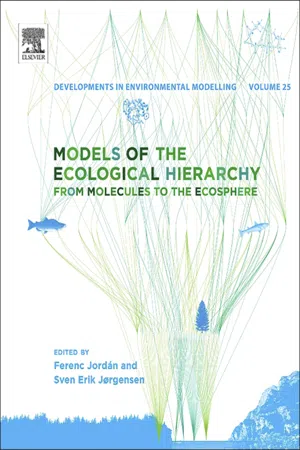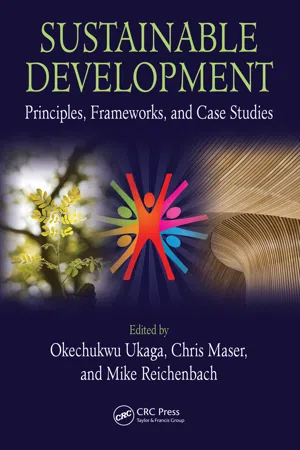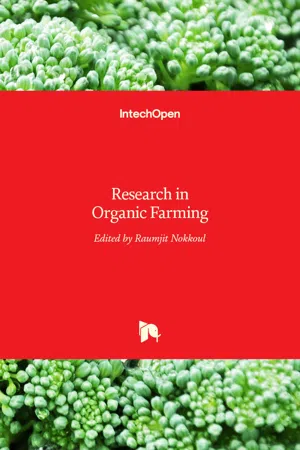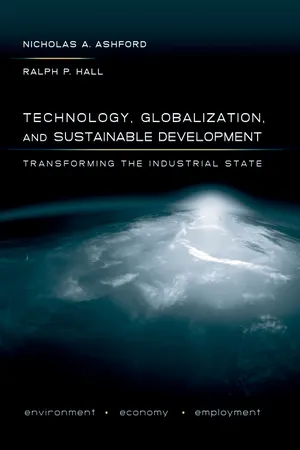Geography
Ecological Footprint
The ecological footprint measures the amount of biologically productive land and water required to support a person's lifestyle and consumption habits. It takes into account factors such as food consumption, energy use, and waste production. This concept helps to assess the impact of human activities on the environment and provides insight into sustainability and resource management.
Written by Perlego with AI-assistance
Related key terms
1 of 5
11 Key excerpts on "Ecological Footprint"
- eBook - ePub
Models of the Ecological Hierarchy
From Molecules to the Ecosphere
- (Author)
- 2012(Publication Date)
- Elsevier(Publisher)
Since living renewable resources regenerate using solar energy, a population Ecological Footprint can be said to represent the area continuously required to generate a quantity of photosynthetic biomass energy and material equivalent to the amount used and dissipated by the population’s consumption (Rees, 2003, 2006 ; Wackernagel and Galli, 2007). In other words, the accounting sheds the needed light on how much is being used and how much needs to be preserved that is essential to human well-being. Further, this method of accounting represents the human impact on the Earth in a clear manner (Moffatt, 2000). The Ecological Footprint measures how much of nature’s resources we have, how much of nature’s resources we use, how we use it, and how the resources are distributed among the human population globally (Barrett et al., 2006). Additionally, Shakir Hanna and Osborne-Lee (2011) defined the Ecological Footprint (E F) as a measure of the status of the global ecosystems’ ability to provide service and goods to all human beings that are living on the Earth. Further, the global ecosystems should provide for the needs of all other organisms that exist on the planet and in consequence, which also play a part enabling nature to provide goods and services to human beings. Therefore, the global ecosystems provide for the needs of all living beings on the Earth, including the human beings (Shakir Hanna and Osborne-Lee, 2011). In this way, the E F was born, as an indicator of the carrying capacity of regions, nations, and the globe, and sometimes extended as an indicator of sustainability (Chen et al., 2007; Penela and Villasante, 2008) - eBook - PDF
Sustainable Development
Principles, Frameworks, and Case Studies
- Okechukwu Ukaga, Chris Maser, Michael Reichenbach(Authors)
- 2010(Publication Date)
- CRC Press(Publisher)
As referenced in this paper, the Ecological Footprint is a standardized estimate of the Earth’s biological carrying capacity required to support humanity’s resource use and waste production. 1 Ecological Footprint analysis (EFA) compares the Ecological Footprint with available biocapacity. It compares biological capacity used against what is available on a renewable basis. Distinguishing between EFA and the footprint is important. By itself, the footprint tells us little about sus-tainable resource use; it is simply a measure that increases or decreases as our demands on the environment increase or decrease, without telling us whether or not those demands are sustainable. EFA, on the other hand, is purported to measure sustainability. As noted by Wackernagel et al. Refining the Ecological Footprint 59 (2002), EFA provides a way to “compare renewable natural resource con-sumption with nature’s biologically productive capacity.” When humanity’s footprint is smaller than global biocapacity it is con-sidered sustainable. When it is larger, it is reported to be engaging ecologi-cal overshoot or running a negative ecological balance. Currently, leading global footprint practitioners estimate the amount of ecological overshoot to be roughly 23% (Loh and Wackernagel 2004). Hence, “when we com-pare the current Ecological Footprint with the capacity of the Earth’s life supporting ecosystems, we must conclude that we no longer live within the sustainable limits of the planet” (Loh and Wackernagel 2004). In part, because the footprint embodies a vast amount of information in a single quantitative measure and attempts to operationalize well-known concepts of carrying capacity and sustainability, its popularity is burgeon-ing among sustainability analysts and practitioners in academic, govern-ment, nonprofit, education, and business circles. - eBook - PDF
- Raumjit Nokkoul(Author)
- 2011(Publication Date)
- IntechOpen(Publisher)
3 Ecological Footprint and Carbon Footprint of Organic and Conventional Agrofoods Production, Processing and Services Iuliana Vintila Dunarea de Jos University Galati Romania 1. Introduction The Ecological Footprint (EF) measure the natural capital demand of human activities (Wackernagel and Rees, 1996 and 2002) and reveal the sustainability of consumption patterns on individual, local, national and global scales (WWF, 2008). The Ecological Footprint measure the natural capital demand of human activities (Wackernagel and Rees, 1996) and reveal the sustainability of consumption patterns on individual, local, national and global scales (Arrow, 2002). Ecological Footprint model assumes that all types of energy, material consumption and waste discharge require productive or absorptive capacity of a finite area. Six types of ecological biologically productive area (arable land, pasture, forest, sea space, built-up land and fossil energy land) are used to calculate the Ecological Footprint and ecological capacity (Wackernagel et al., 2002). The Ecological Footprint estimates the ‘‘minimum land necessary to provide the basic energy and material flows required by the economy’’(Wackernagel and Rees, 1996). The consumption elements are converted into a single index: the land area to sustain the lifeliving among human consummation groups. The area of land or sea available to serve a particular use is called biological capacity (biocapacity) and represents the biosphere’s ability to meet human demand for material consumption and waste disposal. The degree of unsustainability is calculated as the difference between actual available and required land. In the original Ecological Footprints model created by Wackernagel and Rees (1996) and reformulated by Chambers et al. (2000), the land areas included were mainly those directly required by households with autoconsumation life style. - Bradley Striebig, Adebayo Ogundipe, Maria Papadakis, , Bradley Striebig, Adebayo Ogundipe, Maria Papadakis, Lauren Heine(Authors)
- 2022(Publication Date)
- Cengage Learning EMEA(Publisher)
60 C H A P T E R 1 Sustainability, Engineering, and Design ACTIVE LEARNING EXERCISE 1.6 How Big Is Your Footprint? The Ecological Footprint assesses how our wealth, lifestyle, produc- tion technologies, and resource management affect our consump- tion of the Earth’s ecological services and natural resources. The Ecological Footprint metric estimates the amount of biologically productive area (land and oceanic) that is required to sustain a particular lifestyle. Although there are criticisms of the Ecological Footprint methodology as described in the text, it is a useful way to understand how individual consumption affects ecosystems and natural resources. In this activity, you will use an online calculator to estimate your own Ecological Footprint. Go to the Ecological Footprint quiz adminis- tered by the Center for Sustainable Economy at footprintnetwork.org. Read the webpage “About the Quiz,” then take the quiz. Answer the following questions: 1. What exactly does this Ecological Footprint calculator measure? What is the global average footprint? 2. If everyone in the world had your lifestyle, how many “planet Earths” would be required to sustain the global population? 3. How does your footprint for carbon, food, housing, and goods and services compare to the national average? Why do you think your footprint for these aspects of your lifestyle is above or below average? 4. For which type of biome (ecosystem) do you have the largest footprint? Pasture, forestland, fisheries, or cropland? 5. Based on your footprint analysis, what can you do to reduce your Ecological Footprint? Source: hddigital/Shutterstock.com The Ecological Footprint essentially reports how many hectares of biocapacity are required to support human consumption for a given lifestyle, at a particular level of economic development, and using a prevailing suite of production technologies and natural resource management strategies.- eBook - ePub
Flourishing Within Limits to Growth
Following nature's way
- Sven Erik Jørgensen, Brian D. Fath, Søren Nors Nielsen, Federico M. Pulselli, Daniel A. Fiscus, Simone Bastianoni(Authors)
- 2015(Publication Date)
- Taylor & Francis(Publisher)
2 in the atmosphere are just a few noticeable examples. Environmental changes indicate that humanity is far from sustainable, as human demand is likely to be exceeding the regenerative and absorptive capacity of the biosphere. Moreover, several studies showed that many of Earth’s thresholds are being exceeded to the extent to which the biosphere’s future ability to provide for humanity is at risk (see Notes 5, 6, and 65). If continued, overshoot will permanently reduce the Earth’s ecological capacity and lead to ecological collapse and social misery. Careful management of human interaction with the biosphere is thus essential to ensure future prosperity; systemic accounting tools are needed for tracking the combined effects of the many pressures that humans are placing on the planet.The footprint methodology is based on six assumptions (see Notes 64 and 66 ):- It is possible to track the annual amounts of resources consumed and wastes generated by countries.
- The majority of these resource flows can be related to the bioproductive area necessary for their regeneration and the assimilation of their waste.
- By weighting each area in proportion to its usable biomass productivity (annual production of usable biomass), the different areas can be expressed in terms of a standardized average productive hectare. They are called “global hectares.”
- The overall demand can be aggregated by adding all mutually exclusive resource-providing and waste-assimilating areas.
- The aggregate Ecological Footprint and biocapacity can be directly compared to each other.
- Area demanded can exceed area supply.
The Ecological Footprint accounts for the appropriation of biocapacity across six distinct land use types (namely: cropland, grazing land, forest land, fishing grounds, built-up land, and carbon uptake land). These land types represent the area requested for the production of crop food and other fiber products (cropland), meat and other animal products (grazing land), timber and others forest products (forest land), fish products (fishing grounds), and shelter and other infrastructures (built-up land); the carbon uptake land represents the area requested to neutralize the CO2 (the only waste the methodology takes into account) and is calculated as the forest area needed to absorb the anthropogenic carbon dioxide emissions. The Ecological Footprint also relates to six demand categories (namely food and fibers, housing, transport, goods and services, and waste). The final Ecological Footprint of an individual or a country is the sum of all these different types of land, irrespective of where they are located (for details about the calculations, see Note 41 ). Average productivity differs between the land use types. As such, for comparability across them, Ecological Footprint and biocapacity are usually expressed in global hectares (gha; see Note 41 - eBook - PDF
Renewables-Based Technology
Sustainability Assessment
- Jo Dewulf, Herman Van Langenhove, Jo Dewulf, Herman Van Langenhove(Authors)
- 2006(Publication Date)
- Wiley(Publisher)
We therefore formally define the Ecological Footprint of a speci-fied population as: Ecological Footprints and Biocapacity 145 the area of land and water ecosystems required on a continuous basis to produce the resources that the population consumes, and to assimilate (some of) the wastes that the population produces, wherever on Earth the relevant land/water may be located. (Rees, 2001) A complete eco-footprint analysis would thus quantify the total ecosystem area that the population effectively ‘appropriates’ to meet its final demand for economic goods and serv-ices, including the area it needs to provide its share of certain life-support functions such as carbon sequestering. In practice, of course, we cannot consider separately every one of the tens of thousands of consumption items available today. However, most of these are included in major consumption categories such as ‘meat products’, ‘legumes and pulses’, ‘plastics’, ‘organic chemicals’ and similar categories that are compiled by national statistical agencies. We are also effectively restricted to those categories of waste such as carbon dioxide and organic nutrients (e.g., nitrates and phosphates) that can readily be represented by an exclusive assimilation area. Indeed, some products such as minerals and concrete are represented in the eco-footprint largely through their carbon sink areas (because of the fossil fuels used to produce them) although relevant mine sites and related degraded land-scapes are also included in the analysis. Sometimes we can ignore organic, nutrient or other wastes if it is reasonable to assume that they are being assimilated by land and water areas that are already included in the eco-footprint calculation because said lands produce some relevant commodity (e.g., agricultural products or fish). Still other wastes such as widely dissipated airborne and waterborne toxic compounds and ozone-depleting chemicals cannot be translated into land area at all. - Stefania Massari, Guido Sonnemann, Fritz Balkau, Stefania Massari, Guido Sonnemann, Fritz Balkau(Authors)
- 2016(Publication Date)
- Routledge(Publisher)
Local policies aiming at sustainability, in the view of life cycle approaches to sustainable regional development, must thus deal with the latter impacts. The Ecological Footprint, to be effectively used to monitor progress towards sustainability, must account for the land requirement to sustain local activities.When conducting an Ecological Footprint analysis, we have to distinguish between the following categories of ecological space (Chambers et al. 2014):- productive land, including arable land, that is, the portion of land more productive in terms of plant biomass and typically used for major crops; pasture that is less productive than arable land and exploited for cattle ranching; cultivated or natural forested land destined to the maintenance of biodiversity;
- built or degraded land earmarked for the development of human settlements that has no more agricultural capacity;
- coastal areas of production attributable to the areas closest to the coast, typically very productive, in which at least 90 per cent of fishery is carried out (De Leo et al. 2014);
- land for the production of energy, the portion of land needed for the sustainable management of energy demand, that is, the absorption of polluting emissions arising from the model of energy policy adopted;
- land assigned for the preservation of biodiversity.
In the following paragraphs, we review some local applications of the Ecological Footprint, showing the results for each type of bio-productive area and the interventions of sustainable development policies adopted or planned to achieve a reduction of the index to the level of biocapacity.A municipal approach to energy land use
Report 11/02 of the University of Oslo, entitled The Ecological Footprint of the City of Oslo, shows that each Oslo citizen has an Ecological Footprint of 7.77 global hectares per capita (including an area of 12 per cent related to biodiversity protection). Of this area, 3.59 global hectares are attributable to the energy land component, which accounts for 52.6 per cent, representing more than half of the total Ecological Footprint per capita. The main local activity that influences this footprint component is transport, which is responsible for a 43.7 per cent of the energy land required per inhabitant, followed by the consumption of food, which contributes 31.73 per cent (ProSus 2002).- eBook - ePub
Sustainability Economics
An Introduction
- Peter Bartelmus(Author)
- 2012(Publication Date)
- Routledge(Publisher)
Demand is expressed as the ‘area required to produce all the resources an individual, population, or activity consumes, and to absorb the waste they generate’ (Ewing et al. 2010 : 8). Further analysis compares the Footprint to nature’s supply of ‘biocapacity’ or area available for resource use and waste absorption. The result is a measure of ecological deficit, if a nation exceeds nature’s capacity of providing environmental services, or an ecological credit, if it keeps some unused capacity for potential services. The implicit idea is to assess the sustainability of using environmental services, taking limits in their availability into account. Calculations for 2007 present an average of 1.8 ha of biocapacity available per person on earth and an average footprint of 2.7 ha. The world thus faces an ecological deficit of 50 per cent of its biocapacity. Figure 2.2 shows the footprints and resulting ecological deficits or credits for major world regions. Figure 2.2 Ecological Footprint 2007, major world regions. The world exceeded its available biocapacity of 18 billion hectares (1.8 ha per person) by an ecological deficit of over 6 billion ha (0.9 ha per person). The USA generated one of the world's highest footprints of 8 ha per person. Free biocapacity in Oceania and Latin America exceeds the footprint of these regions. Source: Ewing et al. (2010). Table 2.2 presents selected national footprint scores and rankings. The USA is second, surpassed only by the United Arab Emirates, with each person using 8 ha of nature on an average. People in poor countries generate much lower footprints than rich ones. Obviously, the production and consumption levels and techniques of industrialized countries require more natural resource inputs and generate correspondingly higher waste and pollution. Depending on the available biocapacity, the level of footprints does not necessarily correlate with the levels of ecological deficits or credits - Jiri J Klemes, Jiří Jaromír Klemeš(Authors)
- 2015(Publication Date)
- Butterworth-Heinemann(Publisher)
EF is defined as a measurement of the human demand for land and water areas and compares the human consumption of resources and absorption of waste with the Earth’s ecological capacity to regenerate (Global Footprint Network, 2010). EF provides an aggregated assessment of multiple anthropogenic pressures (Galli et al., 2012). It is a composite indicator that combines (Toderoiu, 2010): • Built-up area (built-up land footprint)—Area covered by human infrastructure for housing, transportation, and industrial production (settlements, roads, hydroelectric dams, etc.). By best estimates approximately 0.2×10 9 ha or 1.3% of the total land is built-up land. • Land for carbon absorption or uptake (CF)—Biologically productive area required to absorb the CO 2 not sequestered by the oceans (Kitzes et al., 2007). It is calculated using the carbon absorption potential of the world average of forests. The footprint is primarily attributable to fossil fuel burning, international trade, and land use practices (Borucke et al., 2013). • Fishing grounds (fishing ground footprint)—Area of inland and marine waters necessary for primary production of fish, seafood, and other marine products. Approximately 2.3×10 9 ha (6.4% of total water surface) of fishing ground exist (only continental shelves and inland waters are included). • Forest area (forest land footprint)—Area of forest required to support the annual harvest of timber products, fuel wood, and pulp. Approximately 3.9×10 9 ha (26.2% of total land) of forest are available worldwide. • Grazing land (grazing land footprint)—Area of grassland used in addition to crop feeds required to raise livestock for meat, hides, wool products, milk, and dairy. It comprises all grassland used to provide feed for animals, including cultivated pastures as well as wild grasslands and prairies- eBook - PDF
- Subramanian Senthilkannan Muthu(Author)
- 2015(Publication Date)
- CRC Press(Publisher)
The Ecological Footprint Atlas 2010, http://www.footprintnetwork.org/en/index.php/GFN/page/ecological_footprint_atlas_2010. a Population data from the UN FAO. b Forest footprint includes fuel wood. c CF of a nations’ consumption includes direct carbon dioxide emissions from fossil-fuel combustion, as well as indirect emissions for products manufactured abroad. It also includes carbon dioxide emissions associated with extraction of these fossil fuels, such as flaring of gas. Other consumption-related carbon dioxide emissions included in the accounts only of the global total are from cement production and tropical forest fires. d Built-up land includes areas dammed for hydro power. e Biocapacity includes built-up land (see row after EF). 169 Applications of Carbon Footprint in Urban Planning and Geography CF of residents has been closely linked to the development of local towns and the expansion of urban areas. Kim et al. (2010) investigated the relationship between the spatial features and house-hold energy consumption patterns at the local and neighborhood level in a metropolitan area. The authors measured the CF of residents in eight cities on the outskirts of Seoul, Korea. They examined the path analysis model illustrating spatial–behavior relationships on the basis of a household sur-vey and spatial data. The data from a survey estimating the CFs of 1382 households in Gyeonggi-do (the metropolitan area of Korea) were used to calculate the CF of each household. For collect-ing CF data for Gyeonggi-do, 2064 households were surveyed by the Korean Institute Center for Sustainable Development and Green Gyeonggi 21 in August 2008. Eighty-one percent (177) out of 218 neighborhoods in 8 cities were represented by at least one respondent. Housing and travel energy uses are often selected as proxy measures of CF. - Nicholas A. Ashford, Ralph P. Hall(Authors)
- 2011(Publication Date)
- Yale University Press(Publisher)
Technology, Globalization, and Sustainable Development 26 development focus on the condition of the environ-ment (along with trends). In contrast, others attempt to measure whether development activities/trends are likely to be sustainable into the future . The Living Planet Index (LPI) is a good example of the former (WWF, ZSL, et al. 2010). It measures changes in the population of some eight thousand vertebrate spe-cies, providing an indication of the impact of human activity on their habitats. The Environmental Sus-tainability Index (ESI) provides a good example of the latter type of index (Esty, Levy, et al. 2005). By combining a wide range of national-level socioeco-nomic, environmental, and institutional indicators, the ESI calculates the relative likelihood that a na-tion will be able to maintain or enhance its environ-mental condition over the next several generations. 3 Another well-known metric created to measure the environmental burden of human activity is the Ecological Footprint (EF). † Developed by Wacker-nagel and Rees (1995, 1997), this metric attempts to translate human activity into the corresponding eco-logical area required to sustain that activity (Wack-ernagel 2001; Wackernagel, White, et al. 2004). More specifically, an Ecological Footprint “represent[s] the biologically productive area required to produce the food and wood people consume, to supply space for infrastructure, and to absorb the greenhouse gas car-bon dioxide (CO 2 ) emitted from burning fossil fuels” (Wackernagel, Monfreda, et al. 2002). Thus the EF is based on the idea of environmental carrying capacity—that is, the total rate at which renewable resources can be produced (or regenerated) and waste (such as CO 2 ) can be absorbed in sinks.
Index pages curate the most relevant extracts from our library of academic textbooks. They’ve been created using an in-house natural language model (NLM), each adding context and meaning to key research topics.










